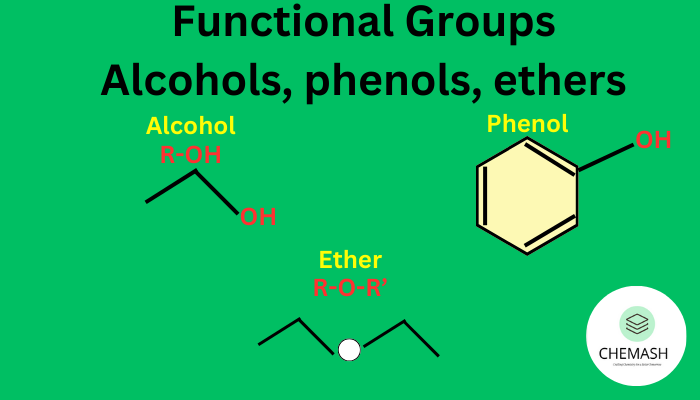Interconversion of Alcohols, Phenols, and Ethers
Master the key conversions among alcohols (R–OH), phenols (Ar–OH), and ethers (R–O–R′) with summary tables, notes, and a self-check quiz.
Alcohols
General Formula: R–OH | Types: 1° (primary), 2° (secondary), 3° (tertiary)
Phenols
General Formula: Ar–OH (–OH directly on aromatic ring) | Example: Phenol (C6H5OH)
Ethers
General Formula: R–O–R′ or Ar–O–R′ | Symmetrical (R = R′) or Unsymmetrical (R ≠ R′)

Interconversion Summary
| From | To | Method |
|---|---|---|
| Alcohol | Ether | Williamson Ether Synthesis (R–O⁻ + R′–X → R–O–R′ + X⁻) |
| Alcohol | Phenol | Oxidation of benzylic alcohol / Diazonium route from aniline |
| Phenol | Ether | Phenoxide (ArO⁻) + R–X → Ar–O–R (Williamson) |
| Ether | Alcohol | Acidic cleavage with HI/HBr (HI > HBr ≫ HCl) |
Alcohol → Ether (Williamson)
Route: R–OH → R–O⁻ (Na/NaH) → R–O–R′ (R′–X, primary) | Avoid 2°/3° halides (E2 risk).
Alcohol → Phenol
Via: (i) Oxidation of benzyl alcohol to phenol under specific conditions; (ii) Aniline → Diazonium → Hydrolysis to phenol.
Alcohol → Alkyl Halide
Reagents: HCl/ZnCl2, SOCl2, PCl5, HBr, HI.
Alcohol ↔ Alkene ↔ Alcohol
Dehydration: conc. H2SO4 → alkene | Hydration: acid-catalyzed addition → alcohol (rearrangements possible).
Phenol → Ether
Method: Phenol + NaOH → ArO⁻; ArO⁻ + R–X → Ar–O–R (e.g., phenol + CH3I → anisole).
Ether → Alcohol
Cleavage: R–O–R′ + HI/HBr → R–I + R′–OH (or two alkyl halides depending on substrate).
Notes
- Phenol is more acidic than alcohol → forms phenoxide (ArO⁻) readily.
- Phenol does not form aryl halide with HX under normal conditions.
- Ether cleavage ease: HI > HBr >> HCl.
- Use primary halides in Williamson to favor SN2 over E2.
Related Topics (Internal Links)
- Classification of Ethers
- Ethers – Structure, Properties & Reactions
- Chemical Reactions of Alcohols
- Chemical Reactions of Phenol
External References
MCQs (with Answers)
- Best method for Alcohol → Ether:
a) Dehydration then hydration
b) Williamson ether synthesis ✅
c) Ozonolysis
d) Friedel–Crafts acylation
Answer: b - In Williamson synthesis, choose:
a) 3° alkyl halide for faster SN1
b) 2° alkyl halide to avoid elimination
c) 1° alkyl halide for clean SN2 ✅
d) Vinyl halide for better reactivity
Answer: c - Order for ether cleavage by HX is:
a) HCl > HBr > HI
b) HI > HBr >> HCl ✅
c) HBr > HI > HCl
d) All equal
Answer: b - Phenol + HX (room temp.) gives:
a) Aryl halide
b) Ether
c) No C–O cleavage to aryl halide ✅
d) Phenyl cation
Answer: c - Alcohol → Alkyl halide reagent set:
a) SOCl2, PCl5, HBr, HI ✅
b) KMnO4 only
c) PCC only
d) O3 only
Answer: a
True / False (with Answers)
- 1. All ethers are cleaved easily by HCl. — ❌ False (HI > HBr ≫ HCl)
- 2. Primary halides are preferred in Williamson. — ✅ True
- 3. Phenol readily forms aryl halide with HI. — ❌ False
- 4. Alkoxide + primary alkyl halide → ether via SN2. — ✅ True
- 5. Dehydration of alcohol gives alkene; hydration reforms alcohol. — ✅ True
